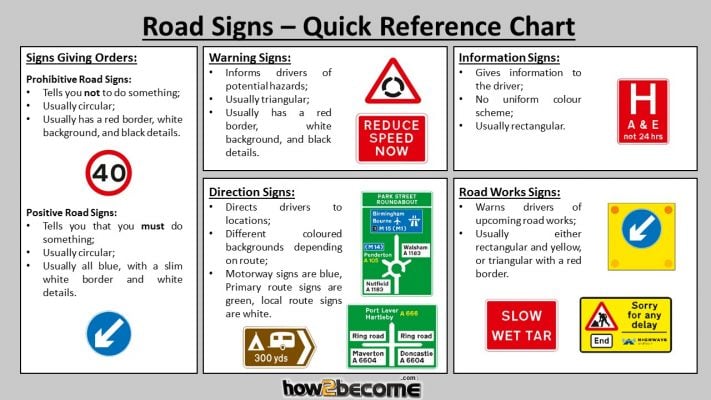If you’re planning on driving in the UK, or intend on learning to drive, it’s vital that you learn the rules of the road. Most of the rules that you need to know are displayed to you when relevant in the form of road signs (also known as traffic signs). Today, we’re going to take a look at different road signs and what they mean. We’ll be looking at each of the following categories of road sign:
• Signs Giving Orders (Prohibitive and Positive Road Signs);
• Warning Signs;
• Direction Signs;
• Information Signs;
• Road Works Signs.
Let’s take a look at these road signs and what they mean in more detail.
Signs Giving Orders
Signs giving orders are divided into two categories: prohibitive and positive road signs. Prohibitive signs tell you not to do something, whilst positive road signs tell you that you must do something. As a general rule, signs which give orders are circular. However, there are some exceptions. It is against the law not to follow the orders shown on these signs.
Let’s look at each of these types of road signs and what they mean:
Prohibitive Road Signs
Prohibitive road signs are those which tell you not to do a certain thing. Generally speaking, they are characterised by a circular shape. They tend to have a red border around them and a white background. Often, the details within the sign are black. Here’s an example of a prohibitive road sign:
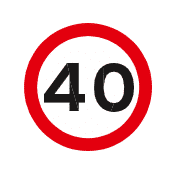
This sign literally means “do not exceed 40 miles per hour”. We know this because it is a circular sign (which means that it is giving orders), it has a red border (which means it is telling you not to do something), and has ‘40’ written inside it. Therefore, it says “you must not exceed 40 miles per hour”.
Positive Road Signs
Positive road signs are the other side of the coin compared to prohibitive road signs. They’re still giving orders, but now they’re telling you that you must do something in particular.
Positive road signs are also usually circular, but are almost entirely blue with a slim white border. The details on the sign are usually white. Here’s an example of a positive road sign:
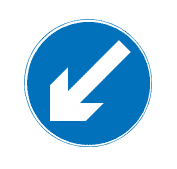
This sign means that “you must keep left”. We know this because the sign is circular (which means it’s giving an order), blue (which tells you that you must do something in particular), and has a white arrow pointing to the left. This means “you must keep left”.
Warning Signs
As the name suggests, warning signs are road signs which give you a warning. This is to make sure that you prepare for conditions on the road that could be dangerous if not taken seriously.
Warning signs are almost always triangular (sometimes this triangle will be upside-down), with a red border and a white background. Usually, the details of the sign are in black.
While some warning signs will clearly spell out the upcoming hazard in words, others are slightly more cryptic. In these cases, an illustration will be used to convey the meaning on the warning sign. You’ll need to learn these individually since some of them aren’t self-explanatory.
Here’s an example of a warning sign:
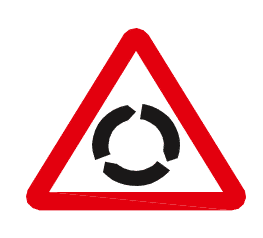
This sign demonstrates that there is an upcoming roundabout, which means that drivers need to get in the correct lane for the exit they want to use. In addition, drivers need to reduce their speed and potentially stop to give way to traffic approach from the immediate right.
Direction Signs
As you can imagine, direction signs are those which give directions to the driver so that they can get to their destination more easily and safely. Like signs giving orders, direction signs are split into multiple categories:
• Signs on motorways;
• Signs on primary routes;
• Signs on local routes;
• Miscellaneous direction signs.
Direction signs come in different colours depending on the route that they’re on. Let’s take a look at these in more detail.
Road Signs on Motorways
Signs on motorways are almost always predominantly blue, with a white border, white details and white text.
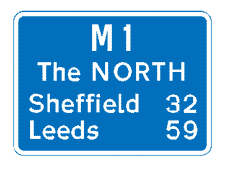
Road Signs on Primary Routes
Signs on primary routes are a lot less uniform than other categories that we’ve looked at so far. However, they do all share the general rule that they have a green background.
Blue panels on these signs show that the motorway starts at the junction ahead. White panels highlight local and non-primary routes from the junction. Brown panels indicate the route to tourist attractions.
In addition, the junction may have a name at the top, such as ‘Park Street Roundabout’. Aircraft symbols denote the route to an airport. Warning panels may also feature on these signs to show potential hazards at and around these junctions.
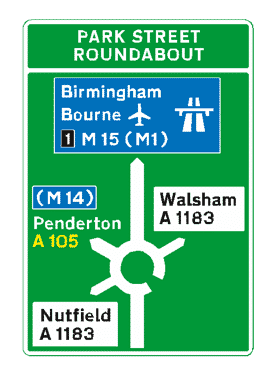
Road Signs on Local Routes
These are signs that you’ll find on non-primary and local routes. These all have black borders and tend to have a white background.
On these signs, green panels show that a primary route starts at the junction ahead. The direction to the motorway is shown by blue panels.
Additionally, route numbers appear on coloured panels. Blue panels with a route number on them (such as ‘M25’) show the direction to a motorway, whilst green panels with a route number on them show the direction to a primary route.
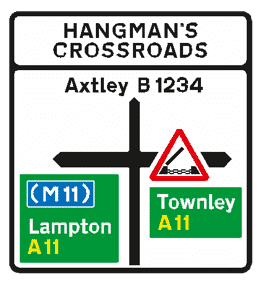
Road Miscellaneous Direction Signs
These signs can take numerous different shapes and sizes. Here’s an example:
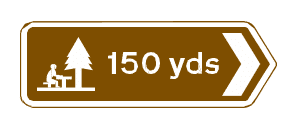
Information Signs
Information signs are ones which provide additional details about the roads that you’re driving on. Most of these signs don’t provide life-or-death information, but instead give extra information to drivers.
However, some of these signs do provide vital information. For example, the sign which states which lanes have priority on slip roads is extremely important for preventing accidents leading onto carriageways. For this reason, you should take the time to learn the information signs.
The unifying feature of information signs is that they’re all rectangular. Beyond that, they can come in a number of different colours. Here’s an example of an information sign:
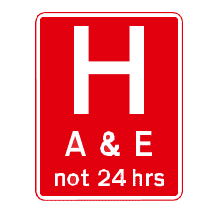
Road Works Signs
The final category of traffic sign that we’re going to look at is the road works sign. As the name suggests, these signs are reserved for times and areas where road works are in effect, and will consequently impact your driving.
There isn’t a single distinct format for road works signs, but many of them tend to have a yellow background, a black background, and black details.
Here’s an example of a road works sign that you might find on the road:
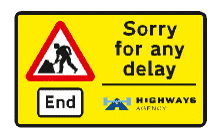
Conclusion
You should now have an idea about the different road signs and what they mean. For quick reference, take a look at the infographic below, which is available as an image or .pdf download.
